
As Elizabeth noted in Fuelling the Political Playing Field, there has been much debate recently about energy prices in the UK. Four of the ‘Big Six’ energy companies have now announced price rises. They average 9.1% – way above the rate of consumer price inflation and even further above the average rate of wage increases. What is more, they are considerably above the rate of increase in wholesale energy prices, which, according to Ofgem, have risen by just 1.7% in the past year.
The bosses of the energy companies have appeared before the House of Commons Energy and Climate Change Select Committee to answer for their large price increases. The energy companies claim that the increases are necessary to cover not only rising wholesale prices, but also green levies by the government and ‘network charges’ for investments in infrastructure. 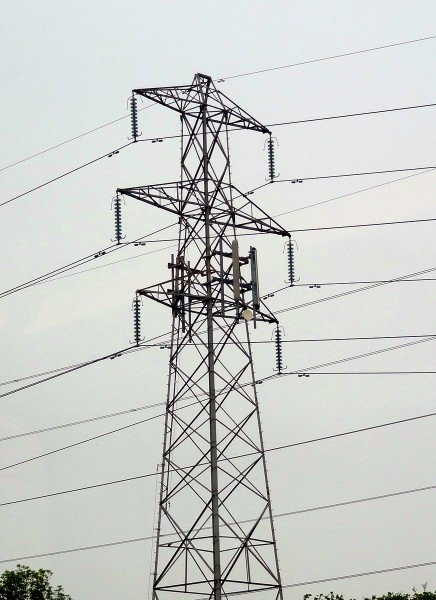 However, it is hard to see how, even taking into account all three of these possible sources of cost increases, the scale of price increases can be justified.
However, it is hard to see how, even taking into account all three of these possible sources of cost increases, the scale of price increases can be justified.
Another possible explanation for the price hikes is that they are partly the result of a system of transfer pricing (see). The energy industry is vertically integrated. Energy companies are not only retailers to customers, but also generators of electricity and wholesale shippers of gas. It is possible that, by the producing/shipping arms of these companies charging higher prices to their retailing arms, the retailers’ costs do indeed go up more than the wholesale market cost. The result, however, is higher profits for the producing arms of these businesses. In other words, a higher transfer price allows profits to be diverted from each company’s retailing arm to its producing arm.
 This is an argument for making the wholesale market more competitive and for stopping the by-passing of this market by producing arms of companies selling directly to their retailing arms. What the companies are being accused of is an abuse of market power and possibly of colluding with each other, at least tacitly, to support the continuation of such a practice.
This is an argument for making the wholesale market more competitive and for stopping the by-passing of this market by producing arms of companies selling directly to their retailing arms. What the companies are being accused of is an abuse of market power and possibly of colluding with each other, at least tacitly, to support the continuation of such a practice.
So is the answer a price freeze, as proposed by the Labour Party? Is it an investigation of the energy market by the Competition Commission? Or is it, at least as a first step, much more openness by the energy companies and transparency about their pricing practices? Or is it to encourage consumers to switch between energy companies, including the smaller ones, which at present account for less than 5% of energy supply? The videos, podcasts and articles consider these issues.
Webcasts and Podcasts
 Energy bosses blame high bills on wholesale prices Channel 4 News, Gary Gibbon (29/10/13)
Energy bosses blame high bills on wholesale prices Channel 4 News, Gary Gibbon (29/10/13)
 Why are energy bosses being questioned? BBC News, Stephanie McGovern (29/10/13)
Why are energy bosses being questioned? BBC News, Stephanie McGovern (29/10/13)
 Key questions Big Six energy companies must answer The Telegraph, Ann Robinson (29/10/13)
Key questions Big Six energy companies must answer The Telegraph, Ann Robinson (29/10/13)
 Energy bosses offer excuses for prices rises The Telegraph (29/10/13)
Energy bosses offer excuses for prices rises The Telegraph (29/10/13)
 Energy bosses face MPs over price rises BBC News, John Moylan (29/10/13)
Energy bosses face MPs over price rises BBC News, John Moylan (29/10/13)
 Energy boss ‘can’t explain’ competitors’ price hikes The Telegraph (29/10/13)
Energy boss ‘can’t explain’ competitors’ price hikes The Telegraph (29/10/13)
 Ovo boss: Competition Commission would take too long BBC News (30/10/13)
Ovo boss: Competition Commission would take too long BBC News (30/10/13)
 Dale Vince: Energy market is ‘dysfunctional’ BBC Today Programme (30/10/13)
Dale Vince: Energy market is ‘dysfunctional’ BBC Today Programme (30/10/13)
 Tony Cocker: Public mistrust energy industry BBC Today Programme (30/10/13)
Tony Cocker: Public mistrust energy industry BBC Today Programme (30/10/13)
 Ed Davey: Energy deals not just for ‘internet savvy’ BBC Today Programme (31/10/13)
Ed Davey: Energy deals not just for ‘internet savvy’ BBC Today Programme (31/10/13)
Articles
Energy giants ‘charge as much as they can get away with’ The Telegraph, Peter Dominiczak (29/10/13)
UK energy markets need perestroika Financial Times (27/10/13)
Britain’s energy utilities must embrace glasnost Reuters, John Kemp (29/10/13)
Small energy firms ‘escape levies’ BBC News (30/10/13)
Is the energy market structurally flawed? BBC news, Robert Peston (30/10/13)
The energy market needs a Competition Commission investigation Fingleton Associates, John Fingleton (12/10/13)
Energy firms raised prices despite drop in wholesale costs The Guardian, Rowena Mason (29/10/13)
Only full-scale reform of our energy market will prevent endless price rises The Observer, Phillip Lee (26/10/13)
Energy Giants Blame Rising Bills On Green ‘Stealth Taxes’ Huffington Post, Asa Bennett (29/10/13)
Big Six energy firms ‘like cartel’ Belfast Telegraph (30/10/13)
Energy boss says he hasn’t done sums on green levies The Telegraph, Georgia Graham (30/10/13)
Graphic: How your energy bills have soared in ten years The Telegraph, Matthew Holehouse (30/10/13)
British energy suppliers’ explanations for price hikes just don’t add up The Guardian, Larry Elliott (31/10/13)
The 18th energy market investigation since 2001: Will this one be different? The Carbon Brief, Ros Donald (31/10/13)
Energy: Is there enough competition in the market? BBC News, Hugh Pym (26/11/13)
Information and Reports
Wholesale [electricity] market Ofgem
Wholesale [gas] market Ofgem
Response on wholesale energy costs Ofgem Press Release (29/10/13)
Response to Government’s Annual Energy Statement Ofgem Press Release (31/10/13)
Real Energy Market Reform The Labour Party
Questions
- Why may the costs of energy paid by the energy retailers to energy producers/shippers have risen more than the wholesale price?
- Explain what is meant by transfer pricing. How could transfer pricing be used to divert profits between the different divisions of a business?
- How can transfer pricing be designed by multinational companies to help them minimise their tax bills?
- Why is policing transfer pricing arrangements notoriously difficult?
- What evidence is there to show that switching between retailers by customers can help to drive retail energy prices down?
- How did the old electricity pool system differ from the current wholesale system?
- Should electricity companies be forced to pool the electricity they generate and not sell it to themselves through bilateral deals?
- Comment on the following: “The current electricity trading arrangements ‘create the very special incentive for the oligopolists. …The best of all possible worlds is where nobody invests. As supply and demand close up, the price spikes upwards, and supernormal profits result.'”
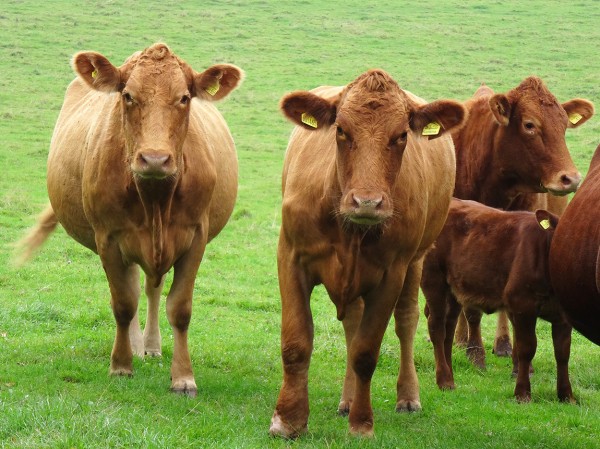 ‘Farm-gate’ milk prices (the price paid to farmers) have been rising in the UK. In July they reached a record high of 31.4p per litre (ppl). This was 5.1ppl higher than in July 2012. There were further price rises this month (October). Sainsbury’s increased the price it pays farmers by nearly 2ppl to 34.15ppl and Arla Foods by 1.5ppl to 33.13ppl. Muller Wiseman is set to raise the price it pays to 32.5p per litre.
‘Farm-gate’ milk prices (the price paid to farmers) have been rising in the UK. In July they reached a record high of 31.4p per litre (ppl). This was 5.1ppl higher than in July 2012. There were further price rises this month (October). Sainsbury’s increased the price it pays farmers by nearly 2ppl to 34.15ppl and Arla Foods by 1.5ppl to 33.13ppl. Muller Wiseman is set to raise the price it pays to 32.5p per litre.
And yet many farmers are struggling to make a profit from milk production, claiming that their costs have risen faster than the prices they receive. Feed costs, for example, have risen by 2.12ppl. On average, farmers would need over 38p per litre just to cover their average variable costs. What is more, exceptional weather has reduced yields per cow by some 7%.
Meanwhile, in the USA, supply has risen by some 1.3% compared with a year ago. But despite this, the prices of dairy products are rising, thanks to strong demand. Cheese and butter prices, in particular, are rising rapidly, partly because of high demand from overseas. Demand for imported dairy products is particularly high in China, where supply has fallen by some 6% in the past couple of months.
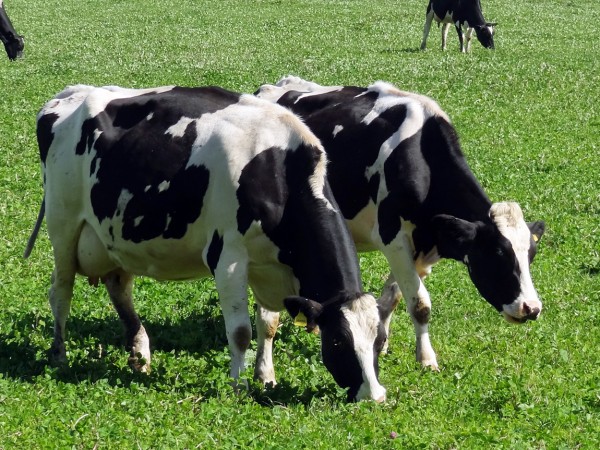 The problem for dairy farmers in the UK is partly one of the power balance in the industry. Farmers have little or no market power. Supermarkets, however, have considerable market power. As large oligopsonistic buyers, they can put downward pressure on the prices paid to their suppliers. These are mainly large processing firms, such as Robert Wiseman Dairies, Arla Foods and Dairy Crest. They, in turn, can use their market power to keep down the price they pay to farmers.
The problem for dairy farmers in the UK is partly one of the power balance in the industry. Farmers have little or no market power. Supermarkets, however, have considerable market power. As large oligopsonistic buyers, they can put downward pressure on the prices paid to their suppliers. These are mainly large processing firms, such as Robert Wiseman Dairies, Arla Foods and Dairy Crest. They, in turn, can use their market power to keep down the price they pay to farmers.
Articles
Dairy farmers renew protests over milk prices Farmers Weekly, Philip Case (5/9/13)
Dairy farmers ‘lost more than 1p/litre last year’ Farmers Weekly, Philip Case (2/10/13)
South West farming businesses and producers still making a loss on milk South West Business (3/10/13)
Q&A: Milk prices row and how the system works BBC News (23/7/12) (note date of this)
Positive Dairy Trend: Rising Milk Production and Strong Demand The Farmer’s Exchange, Lee Mielke (27/9/13)
Chinese supply crisis to delay dairy price adjustment Rabobank (25/9/13)
China milk ‘crisis’ fuels world dairy price rise Agrimoney (1/10/13)
Data
UK milk prices and composition of milk ONS
Combined IFCN world milk price indicator IFCN
Questions
- Give some examples of (a) variable costs and (b) fixed costs in milk production.
- Why may farmers continue in dairy production, at least for a time, even if they are not covering their average variable costs?
- What factors determine (a) the price of milk paid to farmers; (b) the retail price in supermarkets?
- Explain how dairy futures markets work.
- Could the milk processors use their market power in the interests of farmers? Is it in the interests of milk processors to do so?
- Why is there a Chinese “dairy supply crisis”? What is its impact on the rest of the world? What is the relevance of the price elasticity of demand for dairy products in China to this impact?
 For all households, energy is considered an essential item. As electricity and gas prices rise and fall, many of us don’t think twice about turning on the lights, cooking a meal or turning on the heating. We may complain about the cost and want prices brought down, but we still pay the bills. But, is there anything that can be done about high energy prices? And if there is, should anything be done?
For all households, energy is considered an essential item. As electricity and gas prices rise and fall, many of us don’t think twice about turning on the lights, cooking a meal or turning on the heating. We may complain about the cost and want prices brought down, but we still pay the bills. But, is there anything that can be done about high energy prices? And if there is, should anything be done?
The worlds of politics and economics are closely linked and Ed Miliband’s announcement of his party’s plans to impose a 20-month freeze on energy prices if elected in 2015 showed this relationship to be as strong as ever. The price freeze would certainly help average households reduce their cost of living by around £120 and estimates suggest businesses would save £1800 over this 20 month period. The energy companies have come in for a lot of criticism, in particular relating to their control of the industry. The sector is dominated by six big companies – your typical oligopoly, and this makes it very difficult for new firms to enter. Thus competition is restricted. But is a price freeze a good policy?
 Part of the prices we pay go towards investment in cleaner and more environmentally friendly sources of energy. Critics suggest that any price freeze would deprive the energy sector of much needed investment, meaning our energy bills will be higher in the future. Furthermore, some argue this price freeze suggests that Labour is abandoning its environmental policy. Energy shortages have been a concern, especially with the cold weather the UK experienced a few years ago. This issue may reappear with price freezes. As Angela Knight, from Energy UK, suggests:
Part of the prices we pay go towards investment in cleaner and more environmentally friendly sources of energy. Critics suggest that any price freeze would deprive the energy sector of much needed investment, meaning our energy bills will be higher in the future. Furthermore, some argue this price freeze suggests that Labour is abandoning its environmental policy. Energy shortages have been a concern, especially with the cold weather the UK experienced a few years ago. This issue may reappear with price freezes. As Angela Knight, from Energy UK, suggests:
Freezing the bill may be superficially attractive, but it will also freeze the money to build and renew power stations, freeze the jobs and livelihoods of the 600,000-plus people dependent on the energy industry and make the prospect of energy shortages a reality, pushing up the prices for everyone.
There is a further concern and that is that large energy companies will be driven from the UK. This thought was echoed by many companies, in particular the British Gas owner Centrica, commenting that:
If prices were to be controlled against a background of rising costs it would simply not be economically viable for Centrica to continue to operate and far less to meet the sizeable investment challenge that the industry is facing…The impact of such a policy would be damaging for the country’s long-term prosperity and for our customers.
Share prices naturally fluctuate with global events and a political announcement such as this was inevitably going to cause an effect. But, perhaps the effect was not expected to be as big as the one we saw. 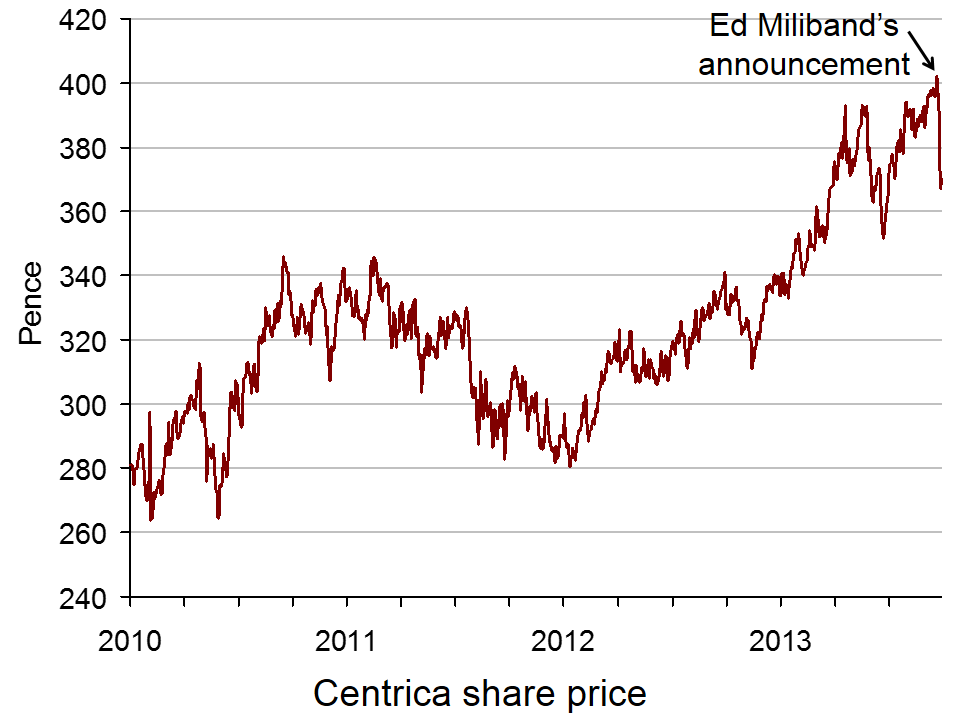 Share prices for Centrica and SSE fell following the announcement – perhaps no great shock – but then they continued to fall. The market value tumbled by 5% and share prices kept falling. This has led to Ed Miliband being accused of ‘economic vandalism’ by a major shareholder of Centrica, which is hardly surprising, given the estimated cost of such a price freeze would be £4.5 billion.
Share prices for Centrica and SSE fell following the announcement – perhaps no great shock – but then they continued to fall. The market value tumbled by 5% and share prices kept falling. This has led to Ed Miliband being accused of ‘economic vandalism’ by a major shareholder of Centrica, which is hardly surprising, given the estimated cost of such a price freeze would be £4.5 billion.
The economic implications of such a move are significant. The announcement itself has caused massive changes in the FTSE and if such a move were to go ahead if Labour were elected in 2015, there would be serious consequences. While families would benefit, at least in the short term, there would inevitably be serious implications for businesses, the environmental policy of the government, especially relating to investment and the overall state of the economy. The following articles consider the aftermath of Ed Miliband’s announcement.
Miliband stands firm in battle over fuel bills plan The Guardian, Patrick Wintour and Terry Macalister (25/9/13)
Michael Fallon calls Miliband’s energy prices pledge ‘dangerous’ Financial Times, Elizabeth Rigby and Jim Pickard (26/9/13)
Britain’s labour treads narrow path between populism and prudence Reuters (26/9/12)
Ed Miliband’s radical reforms will make the energy market work for the many Independent (26/9/13)
Has Labour fallen out of love with Business? BBC News (26/9/13)
Top Centrica shareholder Neil Woodford accuses Labour leader Ed Miliband of economic vandalism The Telegraph, Kamal Ahmed (25/9/13)
Centrica and SSE slide after Labour price freeze pledge The Guardian (26/9/13)
Ed Miliband’s energy price freeze pledge is a timely but risky move The Guardian, Rowena Mason (24/9/13)
Questions
- Why are energy prices such a controversial topic?
- How are energy prices currently determined? Use a diagram to illustrate your answer. By adapting this diagram, illustrate the effect of a price control being imposed. How could it create an energy shortage? What impact would this have after the 20-month price freeze
- Why would there be adverse effects on energy companies if prices were frozen and costs increased? Use a diagram to illustrate the problem and use your answer to explain why energy companies might leave the UK.
- How would frozen energy prices help households and businesses?
- Why were share prices in Centrica and SSE adversely affected?
- Is there an argument for regulating other markets with price controls?
- Why is there such little competition in the energy sector?
 Apple was last week found guilty in the US for its role in the fixing of e-book prices. A subsequent hearing will now be held to determine the damages that Apple will be forced to pay. However, Apple vehemently denies the allegations and looks set to appeal the decision.
Apple was last week found guilty in the US for its role in the fixing of e-book prices. A subsequent hearing will now be held to determine the damages that Apple will be forced to pay. However, Apple vehemently denies the allegations and looks set to appeal the decision.
To understand what the US Department of Justice (the European Commission has also brought a case) is objecting to, we need to look back to how pricing in this rapidly growing market has evolved over time.
Until the end of 2009 e-books were sold under a wholesale pricing model. Here, publishers charge retailers a wholesale price per book and retailers are then free to charge final consumers whatever price they choose. This all changed in the US (there were also similar developments in Europe) during an eventful period of a few days in January 2010 when Apple unveiled its iPad for April release.
The publisher Macmillian proposed that Amazon switch to an agency pricing model under which the publisher sets the retail price. This is typically referred to by economists as Resale Price Maintenance (RPM). Interestingly, RPM has a long history in the book industry. In the UK for example, throughout most of the last century publishers set prices under the Net Book Agreement, until this broke down in the mid 1990s. In addition, in some countries, for example Germany, books continue to be sold under RPM.
Macmillan also threatened Amazon that if it preferred to keep wholesale pricing it would delay the supply of e-book releases to them. Amazon initially responded by refusing to stock Macmillan titles. However, soon after Amazon ceded to Macmillan’s proposal. Despite this, Amazon made clear its dissatisfaction to its customers:
We have expressed our strong disagreement and the seriousness of our disagreement by temporarily ceasing the sale of all Macmillan titles. We want you to know that ultimately, however, we will have to capitulate and accept Macmillan’s terms because Macmillan has a monopoly over their own titles, and we will want to offer them to you even at prices we believe are needlessly high for e-books.
It turned out that 5 of the 6 major publishers (including Macmillan) had already agreed the same agency terms to sell e-books for Apple devices. Like Macmillan, the other publishers all then also imposed agency pricing on Amazon. Furthermore, crucial to the contracts agreed with Apple was a so called ‘most-favoured customer’ clause which guaranteed that e-books would not be sold elsewhere at prices below those charged to Apple customers. Effectively, therefore, this clause made it necessary for the publishers to impose agency terms on Amazon. The Department of Justice objected to this and believed consumers would be harmed due to higher prices. All of the publishers involved eventually decided to settle the case, leaving Apple alone to fight the case in court.
In the decision Judge Cote concluded that:
the publisher defendants conspired with each other to eliminate retail price competition in order to raise e-book prices, and that Apple played a central role in facilitating and executing that conspiracy. Without Apple’s orchestration of this conspiracy, it would not have succeeded as it did in the Spring of 2010.
It is interesting to consider the reasons why the publishers would be keen to take control of the prices Amazon charges for e-books. Evidence suggests that Amazon was frequently retailing e-books at substantial discounts and even below wholesale costs. One explanation for this is that Amazon was keen to increase demand for Kindle devices. The publishers, on the other hand, might well be concerned about the implications of Amazon dominating the e-book market. Potentially, this would give Amazon significant bargaining power over them.
Of course, such dominance might also have knock-on effects on consumer prices in the long-run. Whether the publishers will be permitted to use agency pricing to mitigate such concerns in the future remains unclear and depends on whether the competition authorities object to agency pricing per se or just the coordinated way in which it was achieved.
As the articles below demonstrate, opinion is strongly divided for and against the judgement against Apple.
EU raids ebook publishers in price fixing investigation The Guardian, Benedicte Page and Leigh Phillips (4/3/11)
Apple Faces Damages Trial Over E-Book Antitrust Violation Bloomberg Businessweek, Bob Van Voris, Adam Satariano and David McLaughlin (10/7/13)
Apple played ‘central role’ in ebook price-fixing conspiracy, says federal judge The Guardian, Amanda Holpuch (11/7/13)
US: Apple found guilty, but what happens next? Competition Policy International (11/7/13)
Why It’s Insane That No One Cares About Apple’s Price-Fixing Conspiracy (AAPL) Seattle pi, Jim Edwards (13/7/13)
Apple Learns The Hazards Of Innovation With E-Book Antitrust Ruling Forbes, Daniel Fisher (10/7/13)
Questions
- What are the important features of the e-book market?
- What are the key differences between the traditional and e-book markets?
- To what extent do Amazon and Apple have different incentives in the e-book market?
- Do you think Resale Price Maintenance is more likely to harm competition in the market for traditional or e-books?
- What do you think might be the short and long-run implications of this decision?
 When people take out loans they typically do so to spend and with the UK economy in its current state, many would argue that this is a good thing. The ‘payday loan’ industry took advantage of the weak economy and the squeezed households in the UK and for the past few years, we have seen constant adverts that will appeal to many households. But, is the industry as competitive as the adverts would have us believe?
When people take out loans they typically do so to spend and with the UK economy in its current state, many would argue that this is a good thing. The ‘payday loan’ industry took advantage of the weak economy and the squeezed households in the UK and for the past few years, we have seen constant adverts that will appeal to many households. But, is the industry as competitive as the adverts would have us believe?
An inquiry into this industry has been on-going for some time, and it has now been referred to the Competition Commission, due to ‘deep-rooted problems with the way competition works’. For some, a payday loan is a short term form of finance, but for others it has become a way of living that has led to a debt spiral. Frank McKillop, policy manager at Abcul said:
There is a clear demand for instant credit and across the country we are increasingly seeing members who have debts with multiple payday lenders and a record of rolling over debts, or going to one payday lender to clear the debt to another.
One problem identified by the OFT is that customers have found it difficult to compare costs and this has led, in some cases, to customers paying back significantly more than they originally thought. Customers being unable to repay loans will ring warning bells for many people, with no-one wanting a return to the height of the credit crunch.
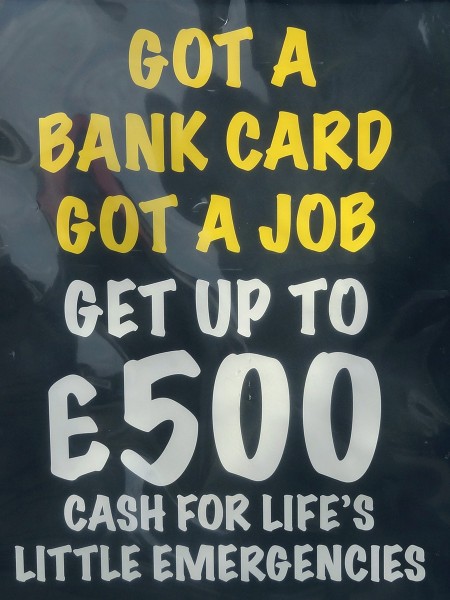 The OFT has criticized payday loan companies for competing not on costs, but on the speed of approval and using certain unapproved tactics as part of their advertising. The selling point of such companies is that you can have the money in a very short time period. However, the criticism is that this leads to loans being given to those who are unable to afford them. Key credit checks are not being done and with late night texts being sent to often financially vulnerable people, it is no wonder that complaints have been received. In a statement, the OFT said:
The OFT has criticized payday loan companies for competing not on costs, but on the speed of approval and using certain unapproved tactics as part of their advertising. The selling point of such companies is that you can have the money in a very short time period. However, the criticism is that this leads to loans being given to those who are unable to afford them. Key credit checks are not being done and with late night texts being sent to often financially vulnerable people, it is no wonder that complaints have been received. In a statement, the OFT said:
The competitive pressure to approve loans quickly may give firms an incentive to skimp on the affordability assessment which is designed to prevent irresponsible lending and protect consumers.
[the business models of companies were] predicated on making loans which are unaffordable, leading to borrowers paying far more than expected through rollovers, additional interest and other charges.
While payday loans are legal and there are many companies offering them, it is what they are competing over, which seems to be in question. The industry itself has begun to change its practices, providing more information to customers, only allowing loans to be rolled over three times and the potential to freeze repayments if the customer gets into financial difficulty. If more stringent checks are completed and hence timing does not become the only grounds for competition, then the problems above may become less significant. With the ongoing OFT inquiry into the practices of the payday loan industry and the continuing demand for such financing, it is likely that we will see much more of both the good and the bad that it has to offer. The following articles consider the investigation.
Webcasts
 Balls warns against payday loans ‘blank cheque’ BBC News (27/6/13)
Balls warns against payday loans ‘blank cheque’ BBC News (27/6/13)
 Payday lender investigation could be delayed by bureaucracy Telegraph, Steve Hawkes (27/6/13)
Payday lender investigation could be delayed by bureaucracy Telegraph, Steve Hawkes (27/6/13)
 Payday lenders to face ‘tougher restrictions’ on advertising BBC News, Simon Gompertz (1/7/13)
Payday lenders to face ‘tougher restrictions’ on advertising BBC News, Simon Gompertz (1/7/13)
 Payday lending rates BBC News, Julio Martino and Stella Creasy (2/7/13)
Payday lending rates BBC News, Julio Martino and Stella Creasy (2/7/13)
Articles
Regulator to investigate payday loan industry Financial Times, Elaine Moore and Robert Cookson (27/6/13)
Q&A: Payday loans BBC News (31/5/13)
Payday loans: reining in an industry that is a law unto itself Guardian (27/6/13)
Payday loans industry to face competition inquiry BBC News (27/6/13)
Payday loans firms face competition inquiry Sky News (27/6/13)
Payday loans market faces competition inquiry Guardian, Hilary Osborne (27/6/13)
OFT refers payday loans to Competition Commission Scotsman, Jane Bradley (27/6/13)
Five reasons why we all need to worry about payday lenders Telegraph, Emma Simon (27/6/13)
OFT documents
Payday lending compliance review Office of Fair Trading (27/6/13)
Questions
- Into which market structure would you place the payday loans industry? Make sure you justify your answer.
- What is the role of the (a) the OFT and (b) the Competition Commission? Do these authorities overlap?
- What part does advertising play in this industry?
- To what extent is the payday loan industry a possible cause of another credit crunch?
- Why has the OFT referred this industry to the Competition Commission?
- To what extent are payday loans an essential part of an economy?
 However, it is hard to see how, even taking into account all three of these possible sources of cost increases, the scale of price increases can be justified.
However, it is hard to see how, even taking into account all three of these possible sources of cost increases, the scale of price increases can be justified. This is an argument for making the wholesale market more competitive and for stopping the by-passing of this market by producing arms of companies selling directly to their retailing arms. What the companies are being accused of is an abuse of market power and possibly of colluding with each other, at least tacitly, to support the continuation of such a practice.
This is an argument for making the wholesale market more competitive and for stopping the by-passing of this market by producing arms of companies selling directly to their retailing arms. What the companies are being accused of is an abuse of market power and possibly of colluding with each other, at least tacitly, to support the continuation of such a practice. Energy bosses blame high bills on wholesale prices Channel 4 News, Gary Gibbon (29/10/13)
Energy bosses blame high bills on wholesale prices Channel 4 News, Gary Gibbon (29/10/13) Why are energy bosses being questioned? BBC News, Stephanie McGovern (29/10/13)
Why are energy bosses being questioned? BBC News, Stephanie McGovern (29/10/13) Key questions Big Six energy companies must answer The Telegraph, Ann Robinson (29/10/13)
Key questions Big Six energy companies must answer The Telegraph, Ann Robinson (29/10/13) Energy bosses offer excuses for prices rises The Telegraph (29/10/13)
Energy bosses offer excuses for prices rises The Telegraph (29/10/13) Energy bosses face MPs over price rises BBC News, John Moylan (29/10/13)
Energy bosses face MPs over price rises BBC News, John Moylan (29/10/13) Energy boss ‘can’t explain’ competitors’ price hikes The Telegraph (29/10/13)
Energy boss ‘can’t explain’ competitors’ price hikes The Telegraph (29/10/13) Ovo boss: Competition Commission would take too long BBC News (30/10/13)
Ovo boss: Competition Commission would take too long BBC News (30/10/13) Dale Vince: Energy market is ‘dysfunctional’ BBC Today Programme (30/10/13)
Dale Vince: Energy market is ‘dysfunctional’ BBC Today Programme (30/10/13) Tony Cocker: Public mistrust energy industry BBC Today Programme (30/10/13)
Tony Cocker: Public mistrust energy industry BBC Today Programme (30/10/13) Ed Davey: Energy deals not just for ‘internet savvy’ BBC Today Programme (31/10/13)
Ed Davey: Energy deals not just for ‘internet savvy’ BBC Today Programme (31/10/13)







